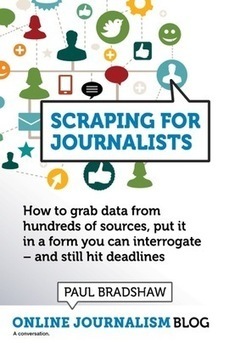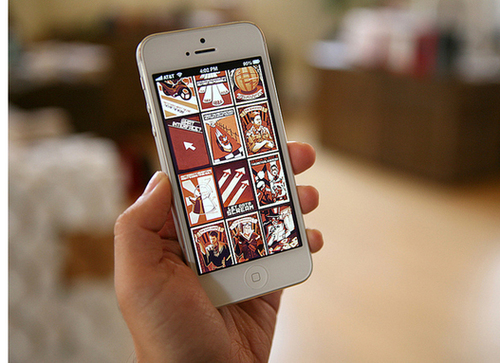Tagged: datajournalism
The Transition to Digital Journalism | kdmcBerkeley
See on Scoop.it – Journalism, media and social
Digital technology presents an often bewildering array of choices for journalists – producing slideshows and video, joining social networks and blogging, using map mashups and mobile devices. The list seems endless.
But survival requires understanding all these new technologies so journalists and news organizations can make informed decisions about why and how to utilize them (see Blogs, Tweets, Social Media, and the News Business, in Nieman Reports).
This guide covers the major digital tools and trends that are disrupting the news industry and changing the way journalists do their jobs.
How to get started as a multimedia journalist
See on Scoop.it – Journalism, media and social
I’ve now covered almost all of the 5 roles in an investigations team I posted about earlier this year – apart from the multimedia journalist role. So here’s how to get started in that role.
Multimedia journalism is a pretty nebulous term. As a result, in my experience, when students try to adopt the role two main problems recur: 1) having a narrow assumption of what multimedia means (i.e. video) and 2) not being able to see the multimedia possibilities of your work.
Multimedia journalism is a very different beast to broadcast journalism. In broadcast journalism your role was comparatively simple: you had one medium to use, and a well-worn format to employ.
Put another way: in broadcast journalism the medium was imposed on the story; in multimedia journalism, the story imposes the medium.
Multimedia also has to deal with the style challenge I’ve written about previously:
“Not only must they be able to adapt their style for different types of reporting; not only must they be able to adapt for different brands; not only must they be able to adapt their style within different brands across multiple media; but they must also be able to adapt their style within a single medium, across multiple platforms: Twitter, Facebook, blogs, Flickr, YouTube, or anywhere else that their audiences gather.”
With that in mind, then, here are 4 steps to get started in multimedia journalism:
How Newsrooms Can Adopt a Mobile-First Mindset | Mediashift | PBS
See on Scoop.it – Journalism, media and social
First, it was the Web. Now, mobile is the “second tidal wave of change about to collide with the news industry,” said Cory Bergman, general manager of Breaking News, a mobile-first startup owned by NBC News Digital.
As more consumers access news on their mobile devices, news organizations are seeing traffic to their websites from desktop computers flatten or decline. And in some regions, such as many parts of Africa, users are leapfrogging the Web altogether and going straight to mobile.
Although many newsroom leaders believe a “mobile, too” approach — a focus on mobile in addition to other platforms — will be enough, that mentality is shortsighted, Bergman said in a recent Poynter Online chat.
Joining Bergman to discuss the news industry’s transition to mobile were Poynter’s Regina McCombs and Damon Kiesow, senior product manager for mobile at the Boston Globe and Boston.com.
See on www.pbs.org
Thanks to the web, journalism is now something you do — not something you are
See on Scoop.it – Journalism, media and social
The fact that it is more difficult than ever to decide who qualifies as a “journalist” may make for a confusing media landscape, and it may trouble some professional journalists and media outlets, but in the long run we are better off.
See on paidcontent.org
The danger of journalism that moves too quickly beyond fact | Poynter.
See on Scoop.it – Journalism, media and social
The best thinking about journalism’s future benefits from its being in touch with technology’s potential. But it can get in its own way when it simplifies and repudiates the intelligence of journalism’s past.
That is happening, to a degree, in a discussion gaining momentum lately that journalism should now largely move beyond fact gathering and toward synthesis and interpretation.
The NSA story is just the latest case that shows the importance, and the elusiveness, of simply knowing what has really happened.
In a Nieman Journalism Lab post, Jonathan Stray made the case recently for moving beyond facts, or what might be called The Displacement Theory of Journalism. “The Internet has solved the basic distribution of event-based facts in a variety of ways; no one needs a news organization to know what the White House is saying when all press briefings are posted on YouTube. What we do need is someone to tell us what it means.”…
See on www.poynter.org
Why Social Media Isn ‘ t Doing For Us What London’s Coffee Houses Did For … – Forbes
See on Scoop.it – Journalism, media and social
Why Social Media Isn’t Doing For Us What London’s Coffee Houses Did For …
See on www.forbes.com
How newspapers and Twitter work together to drive revenue | Twitter Blog
See on Scoop.it – Journalism, media and social
Like television, Twitter and newspapers go together. Not only as a place to break the biggest live stories of the day, but as a way to connect newspapers to their readers and extend relationships with advertisers.
For Linda Grant, managing director of the UK’s free national newspaper @MetroUK, Twitter not only provides a window into the lives of the paper’s readers; it contributes to the bottom line.
Grant (@UrbanLinda), who has been managing director of Metro since 2011, spoke to Twitter (full video below) about how she uses the platform and recalls the moment it struck home that the way news was being reported was changing. That moment was a summer afternoon two years ago when news of the tragic death of singer Amy Winehouse broke.
“The first time it really drove home the power of Twitter and how things had changed was on a late Saturday afternoon when I saw a Tweet saying that Amy Winehouse had died. The speed at which that story unfolded and the way in which I felt it reported live by the power of the network I was on, rather than broadcast media, really blew me away and signalled to me that things had changed,” Grant recalls.
Twitter has long been part of Grant’s routine. She uses it to see what readers are saying about Metro, which distributes 1.3 million copies each weekday morning, in terms of customer service and as a way to grow the paper’s relationship with readers.
See on blog.twitter.com
Tool for journalists: Repost, for embedding articles
See on Scoop.it – Journalism, media and social
Repost creates an embed code for a whole article, allowing you to embed it in the same way as you would a YouTube or Vimeo video
See on www.journalism.co.uk
I cani da Guardian dei giornali
See on Scoop.it – Journalism, media and social
Cosa possono fare le grandi e piccole testate per trasformare il brand in un nuovo motore dell’editoria? La storia del Guardian e quel bar che ha cambiato il rapporto con i lettori
See on www.ilfoglio.it
Send, per inviare velocemente i testi direttamente al sistema editoriale del tuo giornale
Send è l’editor di testi, semplice e funzionale, ideale per freelancers e giornalisti. Permette di semplificare e velocizzare il lavoro, grazie all’invio DIRETTO dei testi a qualsiasi sistema editoriale del mondo.







